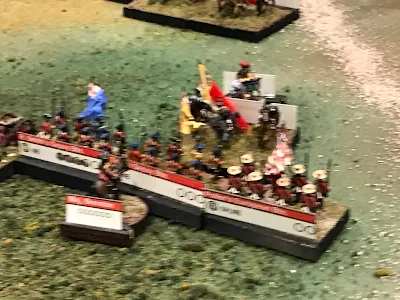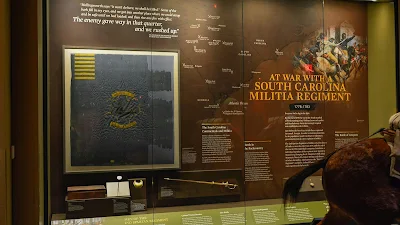Saturday, September 14, 2024
Battle of Brandywine game by Oldenburg Grenadiers
Saturday, August 31, 2024
Blog Issues
My apologies but somehow all comments on my blog have disappeared! Not sure how it happened but everything is now marked removed. So, please know I have not removed anyone comments and I am working on the issue
Thursday, August 29, 2024
Jutland 3D Game
How many of you remember the old Avalon Hill Jutland game? I had it and always wanted to play it. Something about big fleets of battleships. But it never happened. Could not get people interested enough to learn the rules and not enough space. So my game sat and gathered dust. Fast forward to this week and I finally got to play a game.
John, who hosted the game has made it visually interesting. He took and Xeroxed the card board counter. These were cut out and glued to magnetic bases. He then painted 1:48000 scale ships and glued them to the counters. You now have a visually pleasing game which plays simply but looks good. Outstanding! Rules used were right out of the box which provided a simple but enjoyable game.
As to the battle itself it was a tactical German victory but a strategic British victory. British battle crusiers sunk at a alarming rate but otherwise the capital ships took and gave out tremendous damage.
The Germans lost one capital ship when it lost all power for four turns and the British main line if ships passed by firing at it one ship at a time. Otherwise the German fleet sunk a number of weak battle crusiers then turned tail to run home to Germany.
Tuesday, August 27, 2024
Club Game Night
Friday was another club game night! One if the great advantages of being in a club is you can try out different periods and games you normally don't play. Here was the round up.
Byron Chaplin - Wandiwash 1760
Rules: Volley & Bayonet, 15mm, 4 Players
Until January 22, 1760, the Compagnie des Indies of France and the British Honourable East India Company were evenly matched in India. But after the pivotal Battle of Wandiwash the British lion was ascendant on the subcontinent, while the sun of the House of Bourbon was in decline.
This positional battle almost has it all: Royal infantry, company troops and sepoys on both sides, French Marines, British grenadiers, European cavalry and native horse. The French, under the Compte Lally de Tollendal are not foreordained to lose. The British, led by Col. Eyre Coote, have to use their resources well and break the siege of Wandiwash. Do you have the stuff to make or lose an empire?
Mike Coppinger - Battle of Heraclea
Rules: Hannibal at the Gates, 28mm, 6 Players
The Battle of Heraclea takes place in 280 B.C. between the Romans under Consul Publius Valerius Laevinus and the combined forces of Magna Graecia (Southern Italy) and Epirus. Pyrrhus, King of Epirus, will be commanding the combined Greek forces of Magna Graecia and Epirus.
AJ Wright - Counter Attack at Röyttä
Rules: Iron Cross Action, 28mm, 6 Players
Germans counter attack at Röyttä to regain control of the crossing of the Torino river. This crossing is essential to the German withdrawal from Northern Finland.
Monday, August 19, 2024
Continental line Flags
These are all images of flags I found on the internet. They give a wide variety of historical flags that can be used for your miniature regiments. You just need a good printer and paper with some patience. They also give you a variety of historical flags not always used. That's too bad as they look great and add a lot.
Here are a few images of folded flags. I have never had goid luck doing these but others I know have.
Sunday, August 18, 2024
Basic Flag Information from the American Rev War
I got a couple emails concerning flags used during the American Revolution. These centered on American Continental Regimental colors. In addition I got a few questions about Germanic colors.
Here are some recommendations for books and especially articles. There is not much out there but here are a number of sources I gave found especially useful. In a follow up I will post a few good images of flags you can copy and print later.
To start I would read my post on the Gostelowe flags which gives us the basics of the American Continental line.
https://bravefusiliers.blogspot.com/2020/08/what-were-gostelowe-flags.html
Books:
Richardson, Edward W. Standards and Colors of the American Revolution
Best single book out there. Price can be pricey if you can find a copy. remember inter library loan us your friend and can often find you a copy to borrow.
Gerhardi Davis Regimental colors in the War of the Revolution
The first book published in the subject and still very useful. The book is a alike online on the internet!
https://openlibrary.org/books/OL6989778M/Regimental_colors_in_the_war_of_the_revolution
Articles:
Here are a number of articles I found very useful. Most are from the Company of Military Historians. Others are privately published. If you want drop me a email and I will send a copy to you. This is one of the best parts of our hobby in sharing information.
Donald Host, Liberty or Death on military colors
Donald Host, Regimental Colors Of the Continental Army
Military Collector and Historian
Steven Hill, Hessian Flags of the American Revolution 1775-1783
Zlatich, Marko. " Regimental Standards of William Heath's Brigade of Continental Foot, 1776"
Military Collector and Historian, 33 (Winter 1981), pp. 174-175.
Sunday, August 11, 2024
Spartan Militia Regiment Flag
Here is some exciting news. Thank you for Bill on the Fire & Drum miniature board for bringing this to my attention. The Museum of the American Revolution has on display a Militia flag from the Spartan SC regiment. There are so few colors still in existence that any new one adds to our knowledge. And this one is amazing! Pictures on this post are all from the Museum of the American Revolution.
Here is the blurb from the museum about it:
"after being hidden away for more than two centuries, this flag is on public display at the Museum for the first time since it flew over the regiment during the Revolutionary War. The newly discovered flag is one of fewer than half a dozen surviving Revolutionary War flags from the South. The regimental flag of the 2nd Spartan Regiment marked its position on the battlefield. The flag shows a “spartan dog” as well as a rattlesnake. The dog symbolizes a bloodthirsty man, from a reference in Shakespeare’s Othello. The snake appears in many Middle and Southern colonial images as an American symbol of defense. Revolutionaries often used the rattlesnake to symbolize American resistance, but questions remain about the meaning of the snake and the dog. Does the snake represent American resistance and unity or the British threat? Does the Spartan dog represent scrappy South Carolinians or bloodthirsty redcoats and loyalists?"
Most interesting! Recently I had considered not giving militia units colors. I will have to reconsider this.
For comparison here is a modern reconstruction of the colors of the 2nd South Carolina Regiment of the Continental line. Some similarities.

.jpg)





































